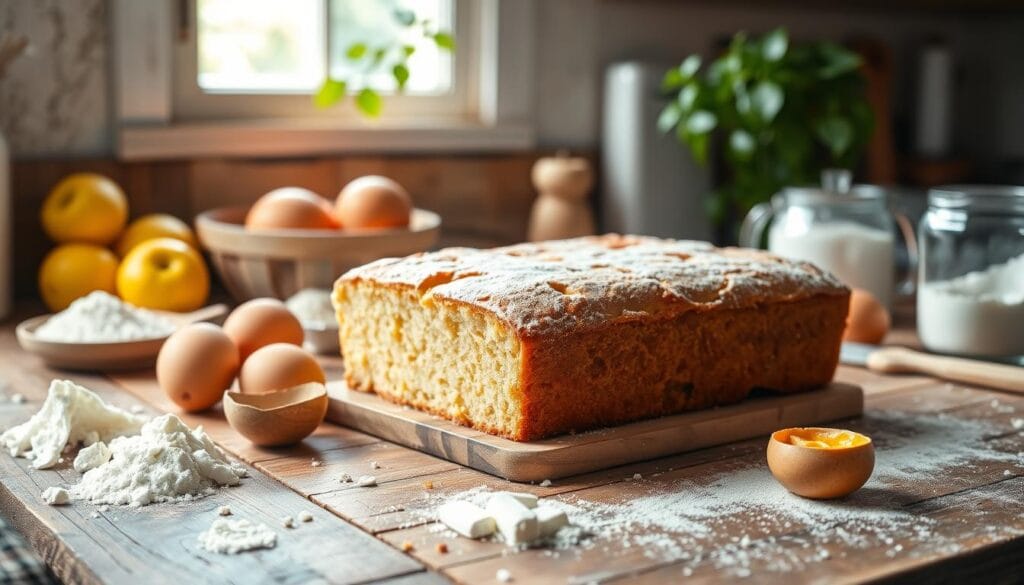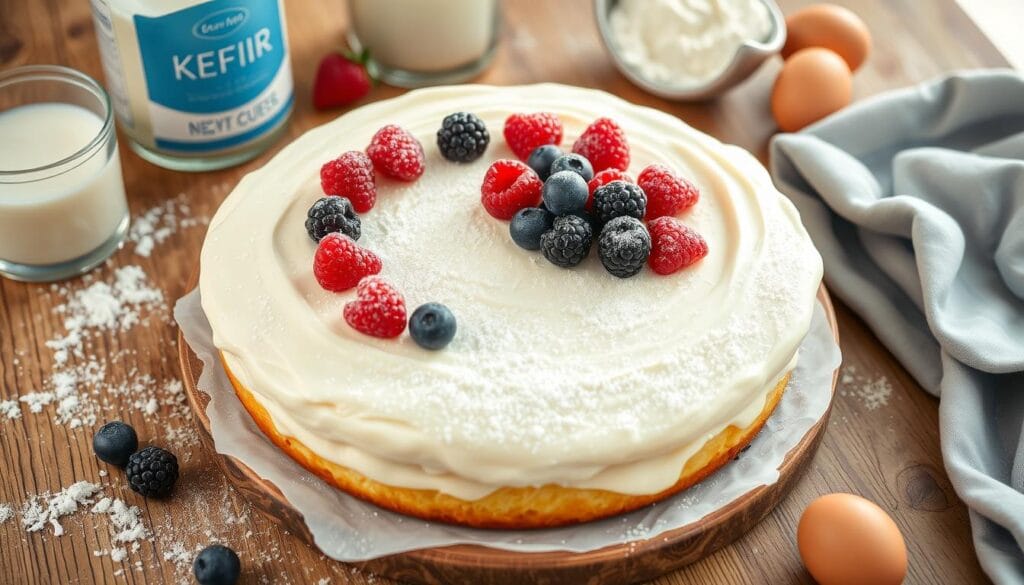
Kefir Sheet Cake Recipe makes baking a cake from scratch delightfully simple. But, when you discover kefir, it becomes even easier. Kefir, a fermented dairy product, makes cake light, fluffy, and moist. It adds a subtle tang that balances sweetness perfectly.
Whether you’re new to baking or experienced, this kefir sheet cake recipe is a must-try. It’s a game-changer.
I’ve always loved baking, and kefir adds magic to it. Its unique properties, like probiotics and leavening agents, make the cake a joy to eat and prepare. With this easy cake recipe, you’ll soon be making homemade masterpieces. You’ll impress your family and friends with your baking skills.
Table of contents
Introduction to Easy Homemade Kefir Sheet Cake Recipe for Beginners
Baking with kefir opens a world of moist, flavorful cakes. This probiotic-rich dairy product makes your baked goods better and healthier. The kefir sheet cake recipe is perfect for anyone looking to get creative in the kitchen.
Benefits of Baking with Kefir
Kefir is a fermented milk product that boosts gut health. It adds a tangy flavor to your baked goods. This flavor complements both sweet and savory tastes.
The acidity in kefir also makes your cakes light and fluffy. This texture is hard to resist.
Why This Recipe is Perfect for Beginners
This kefir sheet cake recipe is great for beginners. It uses simple ingredients and easy techniques. The one-bowl mixing makes baking easy and fun.
What Makes This Cake Special
This kefir sheet cake is special because of its texture and flavor. It’s also very versatile. You can make it for any occasion or just because you want something homemade.
You can try different flavors like citrus, spices, or chocolate. The recipe lets you create a cake that’s truly yours. It will impress everyone who tries it.

Understanding Kefir and Its Role in Baking for Easy Homemade Kefir Sheet Cake Recipe
Kefir is a fermented dairy product from Eastern Europe and Western Asia. It has a tangy taste and a creamy texture. Adding kefir to your baked goods makes them moist and tangy.
The fermentation of kefir creates probiotic cultures. These cultures add flavor and health benefits. They help with digestion and boost the immune system.
Kefir can replace buttermilk, yogurt, or sour cream in recipes. This lets you try new flavors and textures. Your kefir in baking projects will stand out.
| Benefits of Kefir in Baking | Nutritional Breakdown |
|---|---|
|
|
Using kefir in baking can make your creations special. Try it in a classic kefir in baking sheet cake or with other fermented milk products. Kefir can take your probiotic baking to new heights.

Essential Ingredients and Equipment Needed for Easy Homemade Kefir Sheet Cake Recipe for Beginners
To bake a delicious kefir sheet cake, you need some key ingredients and tools. We’ll cover the pantry staples and baking equipment you must have. This will help make your cake a big hit.
Basic Pantry Staples Required
- 2 cups of all-purpose flour
- 1 tsp of baking powder
- 1/2 tsp of baking soda
- 1/4 tsp of salt
- 1 cup of sugar
- 2 large eggs
- 1 cup of kefir
- 1/2 cup of vegetable oil
- 1 tsp of vanilla extract
- Optional: 1 tsp of lemon zest
Kitchen Tools You’ll Need
- Mixing bowls
- Whisk
- Spatula
- 9×13-inch sheet pan
- Parchment paper
- Measuring cups and spoons
Ingredient Substitutions Guide
If you have dietary needs or preferences, here are some substitutions:
- Plant-based kefir can replace dairy-based kefir
- Gluten-free flour blend can substitute all-purpose flour for a gluten-free option
- Unsweetened applesauce can be used instead of vegetable oil for a healthier choice
With these ingredients and tools, you’re ready to make a moist and tasty kefir sheet cake. Now, let’s get your kitchen ready for baking.
Preparing Your Kitchen for Easy Homemade Kefir Sheet Cake Recipe Success
Before starting your kefir sheet cake baking, make sure your kitchen is ready. This guide will help you with the kitchen preparation, baking setup, and mise en place needed for a great homemade kefir sheet cake.
- Preheat your oven to 350°F (175°C). This temperature is perfect for baking a moist and fluffy kefir sheet cake.
- Prepare your baking pan by greasing it with butter or using parchment paper. A 9×13 inch or half-sheet pan is best for even baking.
- Get all your ingredients ready and let them come to room temperature. Accurate mise en place is crucial for smooth baking. Measure your kefir, sugar, eggs, oil, flour, baking soda, salt, and vanilla extract carefully.
- Collect your essential baking tools, like mixing bowls, a hand mixer or stand mixer, measuring cups and spoons, a spatula, and a wire cooling rack. Having everything ready will make baking easier.
- Make sure your kitchen is well-ventilated and has a clear workspace. This will make your baking setup efficient and fun, letting you enjoy the process.
With your kitchen preparation done, you’re all set to mix, bake, and enjoy the delicious flavors of your homemade kefir sheet cake. Let’s begin!
Step-by-Step Mixing Instructions for Easy Homemade Kefir Sheet Cake Recipe for Beginners
Baking the perfect kefir sheet cake begins with mixing the batter right. To get the right texture, follow a few simple steps. Let’s explore these steps to make your kefir sheet cake moist, fluffy, and delicious.
Proper Ingredient Incorporation
Start by creaming the unsalted butter and sugar in a big bowl until it’s light and fluffy. This step adds air, making the cake tender. Then, add the eggs one at a time, mixing well after each. This step prevents the batter from curdling.
Slowly add the kefir, folding it gently to keep the batter airy.
Achieving the Perfect Batter Consistency
In another bowl, sift together the flour, baking powder, baking soda, and salt. Add these dry ingredients to the wet ingredients slowly, folding gently. Avoid overmixing to prevent a dense cake. Finally, add the vanilla extract to boost the flavor.
Common Mixing Mistakes to Avoid
- Overmixing the batter: This can result in a tough, dense cake. Mix the ingredients just until they are well combined.
- Adding ingredients in the wrong order: Ensure you follow the proper steps for creaming the butter and sugar, adding the eggs, and incorporating the dry and wet ingredients.
- Using cold ingredients: Room-temperature ingredients, such as butter and eggs, will blend more easily and produce a smoother batter.
By following these mixing steps and avoiding common mistakes, you’ll make a moist and flavorful kefir sheet cake. Remember these tips, and let’s move on to baking in the next section.
Baking Techniques and Temperature Guidelines
Learning to bake a delicious kefir sheet cake is all about the right techniques and temperatures. This step is key to getting a cake that’s moist and tender. It’s ready to make your taste buds happy.
To bake the perfect kefir sheet cake, preheat your oven to 350°F (175°C). This temperature is just right. It helps the cake bake evenly and get a golden-brown crust without drying out. After the oven is hot, put the batter in a greased pan and place it in the center rack.
- Bake the cake for 25-30 minutes, watching it closely. It’s done when a toothpick in the center comes out clean. This means the inside is fully cooked.
- Remember to rotate the pan halfway through baking. This step prevents hot spots and makes the cake texture even.
- Don’t open the oven door too often. This can make the cake collapse or sink in the middle. Let the oven stay steady for the best results.
After baking, let the cake cool in the pan for 10 minutes before moving it to a wire rack. This cooling helps the cake set and prevents it from sticking. Adjust the baking time if your oven or pan is different.
“Achieving the perfect bake is all about finding the right balance of time and temperature. With a little practice, you’ll master the art of creating moist, flavorful kefir sheet cakes every time.”
Remember, the secret to a great kefir sheet cake is to trust your instincts and watch the baking closely. By following these guidelines, you’ll make a treat that will wow your family and friends.
Creative Topping and Frosting Ideas
Make your homemade kefir sheet cake stand out with fun toppings and frostings. Try classic frostings, seasonal fruits, and special occasion decorations. This will turn your cake into a stunning masterpiece.
Classic Frosting Options
For a creamy topping, try cream cheese, buttercream, or whipped cream frosting. These frostings complement the tangy kefir cake perfectly. They blend flavors in a delicious way.
Seasonal Fruit Decorations
Use seasonal fruits to make your cake look great. Summer fruits like raspberries, blueberries, or strawberries are perfect. For autumn, try diced apples or pears.
Special Occasion Garnishes
Make your cake special with occasion garnishes. Add edible flowers, shaved chocolate, or candied nuts. You can also use a kefir glaze for a tangy twist.
For a simple yet elegant finish, dust your cake with powdered sugar. This adds sweetness and beauty to your cake.
| Frosting Option | Seasonal Fruit Decoration | Special Occasion Garnish |
|---|---|---|
| Cream Cheese Frosting | Raspberries | Edible Flowers |
| Buttercream Frosting | Blueberries | Chocolate Shavings |
| Whipped Cream Frosting | Diced Apples | Candied Nuts |
With these creative ideas, your kefir sheet cake will be a masterpiece. It will show off your baking skills and impress everyone who tries it.
Storage and Serving Recommendations
Proper storage and serving techniques are key to enjoying your homemade kefir sheet cake. Follow these easy tips to keep your cake fresh and flavorful:
For short-term storage, keep the unfrosted cake at room temperature for up to 3 days in an airtight container. This keeps the cake moist and prevents it from drying out. If you’ve added frosting or topping, refrigerate it to keep it fresh.
For longer storage, freeze the unfrosted cake for up to 3 months. Wrap it tightly in plastic wrap or aluminum foil to prevent freezer burn. Thaw the cake overnight in the fridge before bringing it to room temperature.
When serving your kefir sheet cake, serve it at room temperature for the best flavor and texture. This lets the cake’s delicate crumb shine. Enjoy it with a hot cup of coffee, tea, or a refreshing glass of milk for a perfect pairing.
For easy serving at gatherings or parties, cut the cake into squares or bars. This makes neat, bite-sized portions that are easy for guests to grab and enjoy.
“Proper storage and serving techniques can make all the difference in enjoying your delicious homemade kefir sheet cake to the fullest.”
Troubleshooting Tips and Common Issues
Baking the perfect kefir sheet cake is a delicate task. But with a few tips, you can fix common problems. Let’s look at some issues and how to solve them.
Dense or Dry Cake
A dense or dry cake often comes from overmixing the batter. Mix ingredients gently and avoid mixing too much when combining wet and dry parts. Too much mixing can make the cake tough and dense.
Sunken Center
A sunken center in your cake might be from underbaking or opening the oven door too soon. Make sure your oven is hot enough. Wait until the cake is almost done before checking it. The right baking time and temperature are key for a cake that rises well.
Kefir Flavor Too Strong
If the kefir flavor is too strong, try using less kefir. Start by cutting down the kefir by 2-3 tablespoons. Add more vanilla or a bit of salt to balance the taste. Find the right mix of kefir and other ingredients for your liking.
| Common Baking Issue | Possible Causes | Solutions |
|---|---|---|
| Dense, Dry Cake | Overmixing batter | Gently mix ingredients, avoid over-mixing |
| Sunken Center | Underbaking, opening oven too soon | Ensure proper baking time and temperature, resist opening oven |
| Strong Kefir Flavor | Too much kefir in recipe | Reduce kefir amount, increase vanilla or salt |
Baking is a learning journey, and with practice, you’ll get better. Keep these tips in mind and enjoy the fruits of your labor. Happy baking!
Professional Tips for the Perfect Texture
Getting the perfect cake texture is an art that needs careful attention. As a professional baking expert, I’m excited to share my top tips. These will help you make moist, fluffy, and tender cakes every time.
Moisture Control Methods
The secret to a moist cake is using high-quality kefir. Kefir adds a tangy flavor and keeps the cake moist. For more moisture, brush the cake with kefir syrup before frosting.
Achieving the Ideal Crumb
The crumb of a cake is key for a great texture. Sift dry ingredients like flour and baking powder to avoid dense spots. Creaming butter and sugar well adds air, making the crumb light and airy.
Temperature Control Secrets
Controlling the temperature is crucial for baking the perfect cake. Bake at a steady 325°F for even rising and the best crumb. Don’t open the oven door too often to prevent collapse. Use an oven thermometer to keep the temperature right.
By following these baking tips, you’ll make cakes that impress. You’ll see a cake texture improvement that will wow even the most discerning baking secrets enthusiast. Happy baking!
Conclusion
The kefir sheet cake recipe is easy, tasty, and good for you. It’s great for both new and seasoned bakers. Kefir gives it a tangy taste, a soft texture, and health benefits. This makes it perfect for any event.
Just follow the easy steps and tips in this guide. You’ll make a stunning kefir cake that everyone will enjoy. You can also make it your own, adding your special touch. This lets you have fun and enjoy making homemade desserts.
If you want to add more kefir cake benefits to your meals or just want to try something new, this recipe is ideal. It’s sure to become a favorite in your home. So, get baking, have fun, and enjoy the yummy results of your hard work.
FAQ
What is kefir and how does it benefit baking?
Kefir is a fermented dairy product from Eastern Europe and Western Asia. It’s full of probiotics. In baking, it makes the texture better, adds moisture, and gives a tangy flavor. It’s great as a buttermilk, yogurt, or sour cream substitute.
Why is this kefir sheet cake recipe suitable for beginners?
This recipe is easy to make and uses simple ingredients. It’s perfect for new bakers. You can also customize it for different occasions and skill levels.
What makes this kefir sheet cake unique?
The mix of kefir and traditional sheet cake makes it special. Kefir adds a light, fluffy texture and a tangy taste. It works well with leavening agents.
What are the essential ingredients and equipment needed for this recipe?
You’ll need flour, sugar, eggs, butter or oil, kefir, baking powder, baking soda, vanilla extract, and salt. You’ll also need mixing bowls, a whisk, a spatula, a 9×13-inch sheet pan, parchment paper, and measuring tools.
How should I prepare my kitchen for baking the kefir sheet cake?
Preheat your oven to 350°F (175°C). Grease or line the baking pan with parchment paper. Make sure all ingredients and tools are ready and at room temperature.
What are the common mixing mistakes to avoid when making this cake?
Don’t overmix the batter or add ingredients in the wrong order. Cold ingredients can also cause problems. Aim for a smooth batter and avoid overmixing to get a light cake.
How do I know when the kefir sheet cake is done baking?
Bake at 350°F (175°C) for 25-30 minutes. Use a toothpick to check if it’s done. Rotate the pan halfway for even baking. Don’t open the oven door too often.
What are some creative topping and frosting ideas for the kefir sheet cake?
Try cream cheese, buttercream, or whipped cream frostings. You can also add seasonal fruits, edible flowers, chocolate shavings, or candied nuts. A kefir-based glaze or frosting adds a tangy twist.
How should I store and serve the kefir sheet cake?
Keep the cake at room temperature for up to 3 days in an airtight container. Refrigerate for longer storage or freeze unfrosted cake for up to 3 months. Serve at room temperature for the best taste and texture. Enjoy with coffee, tea, or milk.
How can I troubleshoot any issues with the kefir sheet cake?
Issues like a dense cake or dry texture often come from overmixing or overbaking. A sunken center might be from underbaking or opening the oven too soon. Adjust the kefir amount for moisture and ensure accurate ingredient measurements and oven temperature.
